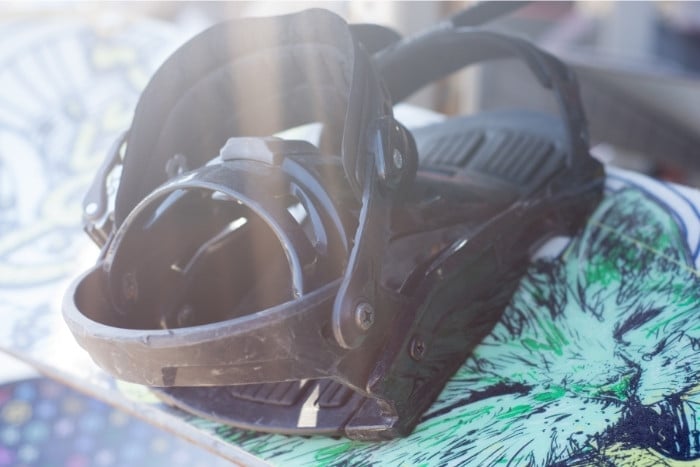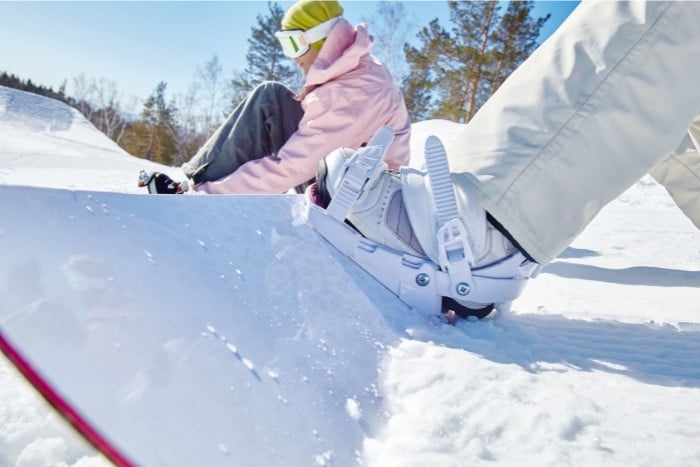Are you in the market for some new snowboard bindings? If so, you need to get the right size. If your bindings are too small, you’re going to have some issues.
If your snowboard bindings are too small, in extreme cases, your boots may not fit on the footbed, preventing you from strapping in. You may be able to squeeze your boots in, but the straps may not fit around them. You could also experience awful foot pain and lack of control while you’re riding.
When you’re looking at buying some new snowboard bindings, you need to ensure that they are not too small. This post highlights what happens when snowboard bindings are too small and how to ensure you get the correct size. You’ll also learn how to fine-tune your binding to fit your boots.
What Happens When You Fit Snowboard Bindings That Are Too Small?
1. Your Boots Don’t Fit in the Bindings
If your boots don’t fit in the bindings, your day on the mountain is over before it has started.
When your snowboard bindings are significantly too small for your boots, the sides of the binding where the straps attach will prevent the boots from slotting in.
Therefore, you have no chance of going snowboarding, so head to the hire shop and get a setup that fits.

2. The Binding Straps Will Be Too Short
Sometimes you may be able to squeeze your boots into small bindings, but the straps won’t reach around your boots. You can adjust the strap length, but it won’t be long enough in extreme cases.
If you can get enough length on the straps for them to fit into the ratchets, you’re going to feel the pinch.
The straps will be super tight over your toes and the top of your feet, cutting blood circulation and causing significant foot pain.
The feeling will be similar to if you were riding in snowboard boots that are too small. After a couple of runs, you’ll be desperate for a setup that fits you properly or be put off snowboarding entirely.
3. Reduced Control
The discomfort of snowboard bindings that are too small could cause your feet to go numb.
This will mean that you don’t feel the slight variations in the snow, and your goggles will fill up with tears of agony. Riding like this will ruin your day on the slopes or even be dangerous.
Your boots won’t fit into the bindings properly if they’re too small. So, your heel won’t sit in the binding heel cup, which gives you control during heel-side turns.
Also, your toes may overhang the binding baseplate, compromising your control when using your toe-side edge.
4. Your Muscles Will Get Tired
Let’s assume you can squeeze your feet into the bindings, the straps can reach around your boots, and you’re shredding the mountain. But after a short while, your feet and leg muscles will start to tire.
This is because you’ll have to compensate for the reduced control your small bindings give you. It won’t take long for foot pain to creep in before it feels like your feet are on fire and you’re falling over.
Your feet and legs will give up from doing too much work. You’ll also feel it the following day, as your legs and feet will be sore in the morning.
How To Choose the Right Size Snowboard Bindings?
You need the correct binding size to get the optimum connection with your snowboard. Well-fitting snowboard bindings help you transfer energy into your board, so it does exactly what you want it to do.
Snowboard bindings need to be sized for your boots and your board. Why? Because oversized boots come with a lot of problems.
You can read about the effects of wearing oversized boots when snowboarding in our article.
Luckily, it’s not too challenging to get the perfect pairing, and there are a few tweaks you can do to dial in the fit.
1. Snowboard Binding Sizing According to Your Boots
Snowboard bindings usually come in six sizes. Small, Small/Medium, Medium, Medium/Large, Large, and Large/Extra Large.
There’s no industry standard for binding size, so a medium binding from one brand could be closer to a large binding from another.
You’ll need to check the binding manufacturer’s sizing tables to match your snowboard boots with bindings.
These tables will be on the brand’s website and give you a range of boot sizes each binding can take.
From checking out various brands’ sizing tables, you’ll notice vast differences between them when matching boots with bindings.
It would be much easier if we had standardized sizes, but these tables are the best we’ve got for now. The tables do not guarantee you’ll get the right-sized bindings, but they’re a great starting point.
The next stage is to try your boots with the bindings to ensure they fit; this is when you can fine-tune your bindings to dial in the fit perfectly.
2. Sizing Your Bindings with Your Snowboard
Your snowboard bindings also need to fit the width of your board. If your bindings are too large, they’ll overhang the edges and drag in the snow, affecting your turns and causing you to wipe out.
If your bindings are too small, you’ll experience all the negatives I’ve already highlighted. But if your snowboard width is suitable for your boot size, the bindings will be the right size for your board.
This is why it’s a good idea to buy your boots first. Then, you can be sure your board will be the correct width for your feet, and you can buy your bindings to match.

Fine-Tuning Your Binding’s Fit
Once you get the appropriate bindings for your boots and board, you can fine-tune their fit; here’s how.
1. Strap Length and Position
You must set your binding straps’ length so they fit snugly around your toes and over the top of your boot. Make sure you get enough length for the ratchets to work.
The straps should be centralized too. This will prevent them from putting uneven pressure around your foot, causing pain.
You can do this by moving the position of the ratchets, as they are attached to the straps with screws.
2. Adjust Your Footbed
The footbed is the bottom of your binding. Most bindings have adjustable footbeds, so you can slide them back and forth to suit the size of your boot.
The footbeds should reach the end of your toes, but no further.
3. Set Your Forward Lean
The highback is the upright piece of the binding that runs up the back of your boot. You can adjust the angle of your highback to give you more control.
Tilting it forwards allows you to develop a more aggressive riding style, so you can attack toe-side carves harder.
You should experiment with forward lean until you get it in a comfortable position that gives you more control.
It will initially feel strange and uncomfortable, but it’s worth playing with and will significantly improve your riding.
4. Highback Position
You can also adjust the highback’s position to fit around your calf and remove any restrictions you may feel.
You can alter the highback angle to make buttering and grabs easier, popular with freestyle riders. It’s easy to do, too, as you adjust the two screws that hold the highback to the binding.
Final Thoughts
Your binding size depends on your boot size. If your bindings are too small, you can experience pain, discomfort, and lack of control.
In the worst-case scenario, you won’t be able to strap in, so matching your bindings with your boots is paramount.
